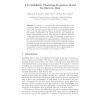Free Online Productivity Tools
i2Speak
i2Symbol
i2OCR
iTex2Img
iWeb2Print
iWeb2Shot
i2Type
iPdf2Split
iPdf2Merge
i2Bopomofo
i2Arabic
i2Style
i2Image
i2PDF
iLatex2Rtf
Sci2ools
PKDD
2005
Springer
2005
Springer
A Probabilistic Clustering-Projection Model for Discrete Data
For discrete co-occurrence data like documents and words, calculating optimal projections and clustering are two different but related tasks. The goal of projection is to find a low-dimensional latent space for words, and clustering aims at grouping documents based on their feature representations. In general projection and clustering are studied independently, but they both represent the intrinsic structure of data and should reinforce each other. In this paper we introduce a probabilistic clustering-projection (PCP) model for discrete data, where they are both represented in a unified framework. Clustering is seen to be performed in the projected space, and projection explicitly considers clustering structure. Iterating the two operations turns out to be exactly the variational EM algorithm under Bayesian model inference, and thus is guaranteed to improve the data likelihood. The model is evaluated on two text data sets, both showing very encouraging results.
| Added | 28 Jun 2010 |
| Updated | 28 Jun 2010 |
| Type | Conference |
| Year | 2005 |
| Where | PKDD |
| Authors | Shipeng Yu, Kai Yu, Volker Tresp, Hans-Peter Kriegel |
Comments (0)

